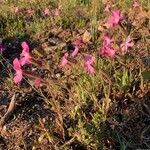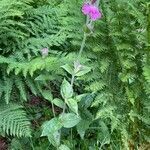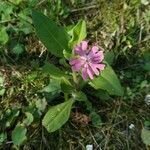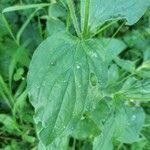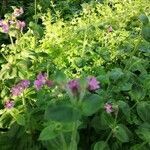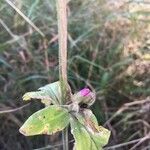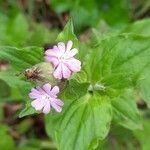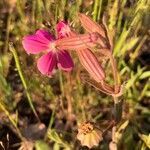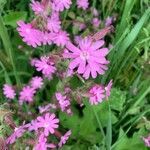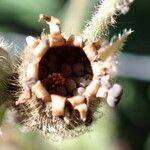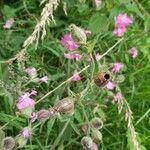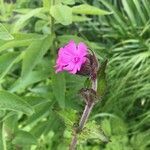Taprooted perennial. Stems unbranched or branched below, with soft eglandular hairs, also becoming glandular above, (15)-30-60-(80) cm tall. Lvs with soft eglandular hairs, green, lanceolate to ovate, acute to acuminate, long-petiolate, becoming sessile above; lamina (2)-3-6-(10) × (1)-1.5-3-(4) cm. Infl. a (3)-7-10-(20)-flowered dichasium, sometimes unequally branched; pedicels 0-1-(2) cm long; bracts lanceolate to ovate, acuminate, green. Fls unisexual. Calyx with short to long glandular and eglandular hairs: in ♂ weakly 10-veined, cylindric, 10-14 mm long; in ♀ weakly 20-veined, ovoid, 12-15 mm long; teeth triangular-acuminate, erect or recurved. Petals pink to magenta; limb 2-fid; claw lobed at base of limb; coronal scales oblong, toothed at apex, 1.5-2 mm long in ♂, 1 mm long in ♀. Styles 5, erect or recurved at apex, 9-11 mm long. Capsule globose to broadly ovoid, included within or = calyx, 10-15 mm long, dehiscing by 10 revolute teeth; carpophore very short. Seeds dull dark brown to grey, reniform, rounded, bluntly warty, 1.2-1.4 mm long.
Herb, perennial, with soft, spreading hairs, almost eglandular. Stems erect, simple or basally branched, 20–90 cm high. Leaves 20–90 mm long, 3–45 mm wide; basal leaves long-petiolate, obovate-oblong; cauline leaves oblong-elliptic, acute to acuminate, shortly petiolate to subsessile; petiole 0–30 mm long. Inflorescence terminal, many-flowered; bracts herbaceous. Flowers unisexual, 13–25 mm diam.; pedicels 0–20 mm long. Calyx cylindrical-ovoid, becoming ovoid in fruit; male 10-veined; female 20-veined, 10–15 mm long, ± glandular-hairy; calyx lobes broadly triangular, acute. Petal limb 5–10 mm long, pale to deep pink, deeply bifid; lobes narrowly obovate. Styles 5. Capsule globose to broadly ovoid, 10–15 mm long, with 10 revolute triangular teeth; carpophore absent. Seeds discoid-reniform, c. 1 mm diam., dark brown, finely and acutely tuberculate.
Much like no. 1 [Silene latifolia Poir.] and hybridizing with it; consistently perennial; stem nearly or quite eglandular; fls red-purple or bright pink, inodorous, opening in the morning; claws hardly auriculate; appendages of the pet 1 mm; fr with recurved teeth; seeds reddish-black, with acute tubercles; 2n=24. Native of Europe, now widespread as an occasional weed in n. U.S. and s. Can. May–Sept. (Lychnis d.; Melandrium d.)
A small herb. It grows 60 cm high and spreads 30 cm wide. It keeps growing from year to year. The leaves are downy and in rings. The flower stems are tall and stiff and branching. The flowers are pink or white.
